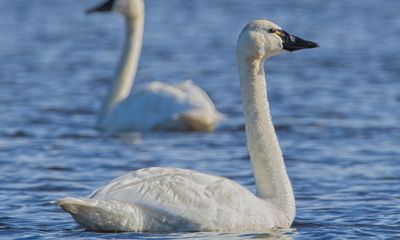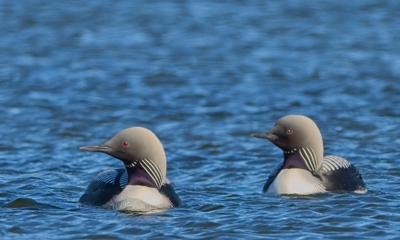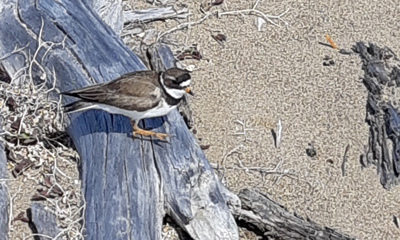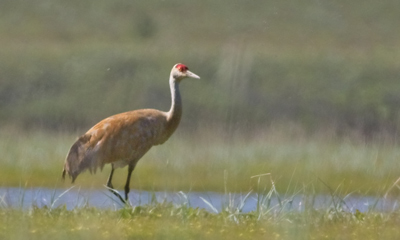
Birds
Pingo Canadian Landmark
The Pingo Canadian Landmark is part of an important habitat for migratory birds travelling between their Arctic summer breeding ground and their winter habitat in the south. Migratory species depart as winter approaches. Autumn migrations begin in August and few birds remain by the end of September, with winter only weeks away.

Tundra swans congregate on small lakes within and around the landmark at the onset of fall migration © Jay Frandsen / Parks Canada
For many species, the landmark is just a rest stop on their journey from Arctic islands further north. They travel thousands of kilometres to their wintering grounds in the southern United States, Mexico, South America, or even Antarctica in the case of the Arctic tern. Waterfowl return to their northern breeding grounds in early spring, as soon as little pools of water begin to form on top of ice or snow, in lakes, wetlands, rivers and creeks. The small lakes within the PCL provide excellent breeding and rearing habitat for many waterfowl species, including tundra swans, which congregate in large numbers on small lakes within and around the landmark at the onset of fall migration.
Bird migration patterns are highly linked to food availability. While food is scarce in the Arctic winter, birds can find an abundance of growing plants, seeds, small invertebrates and other foods during the summer. Wetlands like those found at the landmark offer a particularly rich food source. Fresh, green water plants are a preferred food of tundra swans, geese, and many ducks. King eider ducks prefer aquatic invertebrates including insect larvae, crustaceans, and mollusks, while loons feed on fish. Shorebirds feed on the worms, crustaceans, mollusks and insect larvae that they find in mud or wet sand.

Pacific Loons are just one of the 4 loon species with potential to be seen within or near the landmark © Jay Frandsen / Parks Canada
While most Arctic birds are migrants that temporarily come north to breed, there are 11 bird species that overwinter within the Arctic. These hardy species include rock and willow ptarmigans (Lagopus mutus and L. lagopus), snowy owls (Nyctea scandiaca), dovekies (Alle alle), and Ross's and ivory gulls (Rhodostethia rosea and Pagophila eburnea).
Perching birds including redpolls (Carduelis flammea) and ravens (Corvus corax) can also overwinter at high latitudes. The thick-billed murre (Uria lomvia) and the black guillemot (Cephus grylle) are black and white seabirds that spend most of their time at sea, but come to shore to nest on Arctic seaside cliffs or rocky beaches. Gyrfalcon (Falco rusticolus) are another cliff-nesting species.
Some of these birds are carnivores. Gyrfalcons hunt ptarmigans, snowy owls eat lemmings, and ravens eat voles, lemmings, carrion, and will scavenge garbage in human settlements. Others such as redpolls feed on seeds. The gulls feed on fish and crustaceans found at the edges of the pack ice in the winter.
Waterfowl, including swans, geese and ducks, abound at the landmark. Male long-tailed ducks (Clangula hyemalis) have a white eye patch in the summer and dark eye patch in the winter. These ducks can dive as deep as 60 metres to eat, making them some of the deepest divers among waterfowl species.Footnote 1. King eider ducks (Somateria spectabilis), another diving duck, can also be seen at the landmark.

The landmark offers extremely important habitat for shorebird species (Charadriiformes order). Pictured here is an adult semipalmated plover (Charadrius semipalmatus) in summer plumage © Jay Frandsen / Parks Canada
Dabbling ducks primarily feed near the surface of the water, rather than diving. Dabbling ducks that can be seen at the landmark include green-winged teal ducks (Anas carolinensis) and mallard ducks (Anas platyrhynchos). Mallards are the most abundant duck in Canada. You can look for the blue patch on their wing, and the distinctive bright green head of the males.
Local people have seen Brant geese (Branta bernicla), with their black heads and soft "cr-r-r-rk" sound, nesting near snowy owls to avoid foxes. Other common geese include the lesser snow goose (Anser caerulescens) and greater white-fronted goose (Anser albifrons).
Tundra swans (Cygnus columbianus) are pure white with black bills, legs and feet. Tundra swans congregate in large numbers on small lakes within and around the PCL at the onset of fall migration. Look for the yellow spot in front of their eyes and listen for their high-pitched "wow-wow-wow" sound in flight.
You may hear the famous "oo-ah-ho," also called a yodel, of loons at the landmark. All 4 of Canada's loon species can be seen within or near the PCL, including the red-throated loon (Gavia stellata), Pacific loon (G. pacifica), common loon (G. immer) and yellow-billed loon (G. adamsii). The common loon is the least likely loon to be spotted because the landmark is located just outside of its typical summer range. However, sightings of the common loon have been confirmed in Tuktoyaktuk in the past. These fish eaters are strong flyers and swimmers, and are happy to spend time in fresh or salt water.

Sandhill cranes have dull clay colouring and distinctive red foreheads © Jay Frandsen / Parks Canada
Habitat within the landmark is extremely important to shorebirds (Charadriiformes order) including plovers and sandpipers. During their long migration north, these strong flyers make feeding stops to build up fat reserves in preparation for the stress of Arctic springtime. Some shorebirds are known to have extremely long migrations. White-rumped sandpipers (Calidris fuscicollis) and Baird's sandpipers (Calidris bairdii) travel from southern South America, a journey of over 14 000 km.
Sandhill cranes (Antigone canadensis) can be seen standing on the shores or soaring over the land at the PCL and alongside the ITH. They are identifiable by their dull clay colouring, red forehead, and their large wingspan. Listen for their trumpeting call; it can be heard from great distances.
Related links
- Date modified :